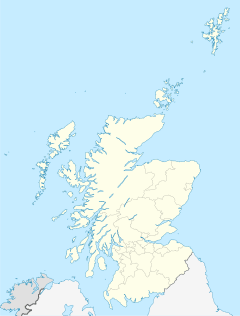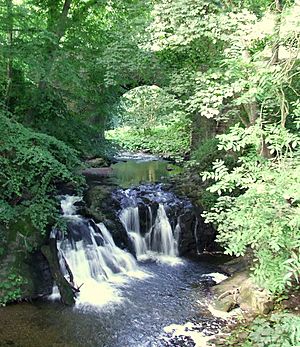Arbirlot facts for kids
Quick facts for kids Arbirlot |
|
|---|---|
| OS grid reference | NO602407 |
| Council area | |
| Lieutenancy area | |
| Country | Scotland |
| Sovereign state | United Kingdom |
| Post town | ARBROATH |
| Postcode district | DD11 |
| Dialling code | 01241 |
| Ambulance | Scottish |
| EU Parliament | Scotland |
| UK Parliament |
|
| Scottish Parliament |
|
Arbirlot (Gaelic: Obar Eilid) is a small village in a countryside area of Angus, Scotland. Its name probably comes from 'Aberelliot' or 'Aber-Eliot'. These names mean 'the mouth of the Elliot Water'. Arbirlot is located west of Arbroath.
The main part of the village is by the Elliot Water. This is about 2.5 miles (4 km) from Arbroath. Arbirlot has a Church of Scotland church and a primary school. The school is about 1 mile (1.6 km) further west.
Contents
What is the Landscape Like in Arbirlot?
Arbirlot village is sometimes called Kirkton of Arbirlot. It sits in the Kelly Den, which was formed by the Elliot Water. The main rock found here is Old Red Sandstone.
Arbirlot became famous among early geologists. This was because of the amazing rock formations in the Kelly Den. A famous geologist named Hugh Miller wrote about these rocks. He described them in his important 1841 book, Old Red Sandstone.
A nature trail follows the Elliot Water. This path connects Arbirlot with Elliot, a former railway junction. Arbirlot is also home to a spectacular 23-foot (7-meter) waterfall!
What is the History of Arbirlot?
Ancient Times and Early Christianity
People have lived in the Arbirlot area for a very long time. There is lots of proof of this from prehistoric times. Old records mention a "druidical temple" that was taken down. A "Pictish crown" was also found here. Many stone piles, called cairns, were also present.
Experts think the "druidical temple" might have been a stone circle. They believe it was near Cairncortie. Many stone arrowheads have also been found in the area. There is even a special rock with cup and ring marks near Craigend.
In 1957, a short cist burial was found. This type of burial is usually from the early Bronze Age. It was close to where an old fortified area was reported in 1910. There are also signs of a possible Roman marching camp near Grahamston Cottages.
The Arbirlot Kirk (church) is dedicated to St Ninian. No one knows exactly when it was built. Some people think it could be as early as the 400s. The garden of the current church house has a standing stone. It has carvings that might be from the Middle Ages. This stone was found when the church was rebuilt in 1831.
Records suggest there might have been a Culdee religious house in Arbirlot. This was a type of early Christian community. It was closed down after Arbroath Abbey was founded in the late 1100s. The title 'Abbe of Arbirlot' was still used for a while. But it was more of an honorary title than a real position. Old maps show where this "college" was located.
Medieval Period
Before Arbroath Abbey was built, the Arbirlot church belonged to the diocese of St Andrews. The bishops owned land east of the Elliot Water. Bishop Roger de Beaumont gave the church to the new Abbey. But he kept the land for the diocese.
The area suffered during the First War of Scottish Independence. This was in the late 1200s and early 1300s. The vicar of Arbirlot was excused from paying his yearly fee in 1323. This was because of "the poverty, sterility, and destruction of the parish". This was caused by the war.
Kelly Castle (also called Kellie Castle) overlooks the Elliot Water. It has a four-story tower from the late 1400s or early 1500s. It was once a strong base for the Mowbray family. The Earl of Dalhousie restored it in the 1800s.
After the Reformation
By the 1600s, the land of Kellie belonged to the Irvines of Drum. In 1629, they promised to give food to the schoolmaster and the poor of Arbirlot every year. In 1679, Alexander Irvine sold the land to George Maule, 2nd Earl of Panmure. This was for £11,000.
In the 1700s and 1800s, many people in Arbirlot were handloom weavers or farmers. The village used to have a mill, a slaughterhouse, two schools, and a post office. It also had a savings bank, an inn, and a library. There were also several shops.
During the Napoleonic wars, Kelly Castle was a known spot for smugglers. They traded illegally with France. In 1830, Thomas Guthrie became the minister of Arbirlot. He later became a famous social reformer. He helped start the Ragged School movement. Guthrie was the minister for eight years. He had also studied medicine. This knowledge was useful when the village had a cholera outbreak.
Clan Elliot
Many people believe that Arbirlot is the original home of Clan Elliot. This clan was moved to the Scottish Borders. Their job was to protect Robert the Bruce's Scotland from English invaders. They did this using a network of peel towers. The Elliots worked with other clans like Armstrong, Scott, and Douglas.
Famous People from Arbirlot
- David Black (died 1603), a minister.
- George Gladstanes (c. 1562 – 1615), a minister in Arbirlot. He later became Archbishop of St Andrews.
- John Guthrie (c. 1580 - 1649), a minister in Arbirlot. He later became Bishop of Moray.
- Alexander McGill (c. 1680-1734), an architect. He was the first City Architect of Edinburgh.
- Rev Thomas Guthrie (1803 – 1873), a minister and helper of others. He was the minister in Arbirlot from 1830 to 1837.
- Rev John Kirk (1795–1858), a minister and writer.
- Alexander Carnegie Kirk (1830 - 1892), an engineering inventor. He was known for the triple expansion steam engine.
- Sir John Kirk (1832 – 1922), a doctor, naturalist, and explorer. He traveled with David Livingstone. He also worked to end slavery. He lived in Arbirlot when he was young.
- Margaret Fairlie (1891–1963), a professor and doctor. She was the first woman to be a professor in Scotland.
- Eileen Ramsay (born 1940), a novelist.
Images for kids
See Also




